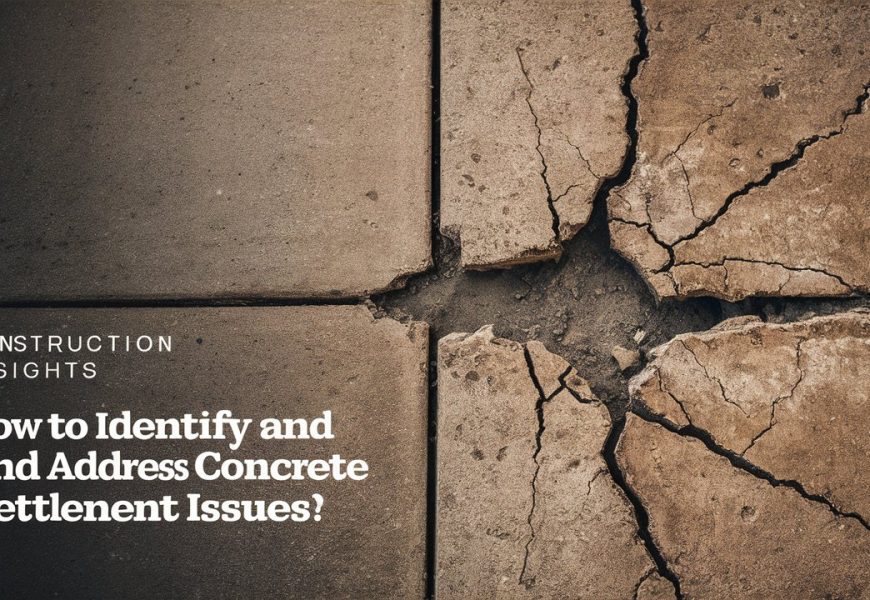When your building’s foundation starts showing signs of wear, every crack and uneven surface tells a story. Concrete settlement isn’t just about aesthetics—it’s a structural issue that can compromise the integrity of your entire property and lead to costly repairs if left unchecked. From hairline cracks in your basement walls to doors that suddenly won’t close properly, these subtle changes can signal serious underlying problems.
Every year, property owners spend millions addressing foundation issues that could have been prevented or minimised through early detection.
Whether you’re a homeowner watching over your family’s biggest investment or a property manager responsible for multiple buildings, understanding concrete settlement is crucial for maintaining safe, stable structures.
This article delves into the telltale signs of settlement, explores what causes these issues, and outlines effective solutions to address them. By understanding these aspects, you’ll be better equipped to protect your property and make informed decisions about repairs and maintenance.
What is Concrete Settlement?
Concrete settlement occurs when the soil beneath a concrete structure compresses or shifts, causing the concrete above to sink, crack, or become uneven. Think of it like a heavy book placed on a soft pillow – over time, the book’s weight causes the pillow to compress and the book to sink unevenly.
Key Aspects of Concrete Settlement:
-
Types of Settlement:
- Uniform settlement: When the entire concrete structure sinks evenly
- Differential settlement: When parts of the structure sink at different rates
- Edge settlement: When the edges of concrete slabs sink more than the centre
- Centre settlement: When the middle of a concrete slab sinks more than its edges
-
Common Causes:
- Soil-Related Issues:
- Poor soil compaction before construction
- Natural soil erosion from water movement
- Expansive soils that change volume with moisture
- Underground voids or deteriorating organic matter
- Environmental Factors:
- Freeze-thaw cycles causing soil expansion and contraction
- Tree roots draw moisture from the soil
- Changes in groundwater levels
- Natural disasters or vibrations
- Construction-Related Problems:
- Inadequate soil preparation
- Poor concrete mix or placement
- Improper drainage design
- Overloading beyond design capacity
-
Warning Signs:
- Visual Indicators:
- Cracks in walls, floors, or foundations
- Uneven or sloping floors
- Gaps between walls and ceilings
- Stair-step cracks in brick walls
- Functional Issues:
- Doors and windows that stick or won’t close properly
- Separating trim or molding
- Uneven cabinet alignment
- Gaps around window frames
-
Impact on Structures:
- Short-term Effects:
- Cosmetic damage to surfaces
- Minor functional issues
- Water pooling in low spots
- Small cracks and separations
- Long-term Consequences:
- Structural integrity compromise
- Increased water damage risk
- Growing repair costs
- Reduced property value
-
Detection Methods:
- Professional Assessment:
- Laser level measurements
- Soil testing and analysis
- Foundation inspection
- Drainage evaluation
- DIY Monitoring:
- Using a marble to check the floor slope
- Measuring crack widths over time
- Documenting changes with photos
- Checking door and window operation
-
Cost Implications:
- Factors Affecting Cost:
- Severity of settlement
- Type of treatment needed
- Size of the affected area
- Accessibility of the site
- Investment Considerations:
- Early intervention costs less
- Prevention is cheaper than cure
- Insurance coverage varies
- Property value impact
Understanding concrete settlement is crucial for property owners and managers because:
- Early detection can prevent major structural issues
- Proper maintenance can extend a structure’s lifespan
- Timely intervention can save significant costs
- The professional assessment ensures appropriate solutions
Critical Signs of Concrete Settlement
Property owners should watch for these key indicators of settlement problems:
- Visible Cracks
- Hairline Cracks: Thin surface fractures that may appear harmless but can worsen over time
- Large Structural Cracks: Wide fissures indicating significant movement
- Diagonal Cracks: Often appearing near windows and doors, suggesting structural stress
- Stair-Step Cracks: Distinctive zigzag patterns in brick or block walls
- Uneven Surfaces
- Sloping Floors: Noticeable tilt or sagging in what should be level surfaces
- Uneven Concrete Slabs: Different heights between adjacent sections
- Sunken Areas: Depressions in concrete surfaces that can collect water
- Structural Warning Signs
- Door and Window Issues: Difficulty opening, closing, or latching
- Separating Trim: Gaps between walls and wooden trim
- Wall and Ceiling Gaps: Visible separation between structural elements
- Water-Related Indicators
- Standing Water: Pools forming near foundations or on concrete surfaces
- Dampness: Persistent moisture in basements or crawl spaces
- Water Stains: Discolouration indicating repeated water exposure
The Root Causes
| Cause Category | Specific Issues | Primary Effects |
| Soil Problems |
|
Foundation movement, Uneven settling, Structural stress |
| Environmental |
|
Crack formation, Progressive damaged oil instability |
| Structural |
|
immediate settling, Ongoing deterioration, Water damage |
Detailed Analysis of Causes
Soil-related issues pose the most common threats to concrete stability. Poor soil preparation during construction can lead to immediate problems, while natural erosion and soil composition changes create long-term challenges. Expansive soils, which change volume with moisture content, are particularly problematic in many regions.
Environmental Factors contribute significantly to concrete settlement. Seasonal temperature changes cause materials to expand and contract, while mature trees can alter soil moisture levels through their root systems. These natural processes gradually impact foundation stability.
Structural Problems often stem from human factors. Exceeding design load limits, inadequate initial construction, or failing to account for local soil conditions can all trigger settlement issues. Professional equipment, such as hire concrete line pumps services, helps ensure proper concrete placement during construction.
Solution Methods and Their Implementation
- Polyurethane Foam Injection
- Advantages:
- Minimally invasive (small injection holes)
- Quick curing time
- Lightweight solution
- Disadvantages:
- Higher material costs
- Not suitable for all soil types
- Requires specialised equipment
- Advantages:
- Mudjacking Process
- Advantages:
- Cost-effective
- Proven traditional method
- Works well for large areas
- Disadvantages:
- Longer cure time
- Heavier solution
- Larger holes required
- Advantages:
- Complete Concrete Replacement
- Advantages:
- Addresses all underlying issues
- Provides fresh start
- Allows for modernisation
- Disadvantages:
- Most expensive option
- Longest completion time
- Major disruption to property
- Advantages:
- Foundation Reinforcement
- Advantages:
- Long-term solution
- Addresses structural issues
- Can prevent future problems
- Disadvantages:
- Complex installation
- Requires extensive planning
- Significant investment
- Advantages:
Essential Preventive Measures
Preventing concrete settlement starts with proper construction practices and continues through ongoing maintenance:
Soil Management
- Conduct thorough soil testing before construction
- Implement appropriate compaction techniques
- Monitor soil moisture levels regularly
- Address drainage issues promptly
Drainage Systems
- Install proper gutters and downspouts
- Maintain positive grading away from structures
- Consider French drains for problem areas
- Regular cleaning and maintenance of drainage systems
Inspection and Maintenance Protocol
- Monthly visual inspections of:
- Foundation walls
- Concrete surfaces
- Drainage systems
- Door and window operation
- Quarterly checks for:
- New cracks or settlement
- Water pooling
- Soil erosion
- Vegetation issues
- Annual professional assessments of:
- Overall structural integrity
- Foundation condition
- Drainage efficiency
- Soil stability
Conclusion
Concrete settlement issues demand prompt attention and professional expertise. Early detection and intervention can prevent minor problems from becoming major structural concerns. Whether you need specialised equipment like concrete line pump hire or comprehensive foundation repairs, choosing the right service provider is crucial.
Frequently Asked Questions
Q: How long does it take for concrete settlement to become visible?
A: Settlement signs can appear within months of construction or develop over several years, depending on soil conditions and construction quality.
Q: Can I fix minor cracks myself?
A: While surface cracks can be temporarily sealed, a professional assessment is recommended to address underlying causes.
Q: What role does weather play in concrete settlement?
A: Weather significantly impacts settlement through freeze-thaw cycles, soil moisture changes, and temperature fluctuations.









